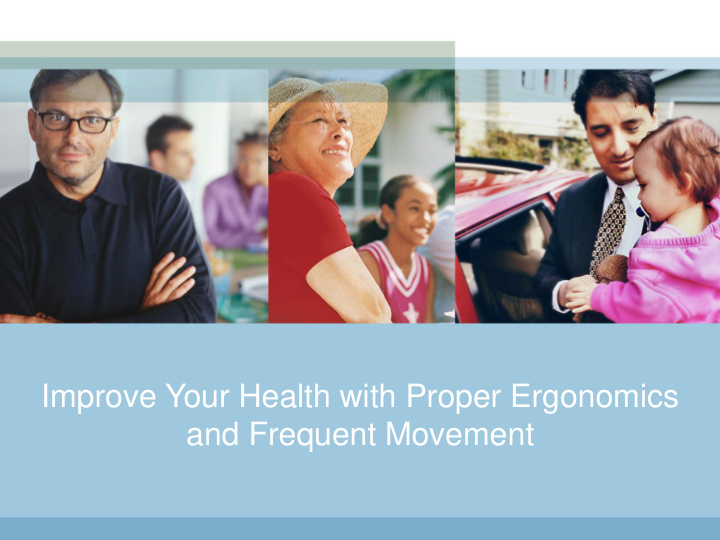



Improve Your Health with Proper Ergonomics and Frequent Movement
Presenter Cedric Arijs, MSc As a counsellor for Workplace Options, Cedric Arijs helps employees and their family members with their needs. After finishing his degree as a clinical psychologist in Belgium, Cedric continued his education abroad with an additional master's programme in sport and exercise psychology. He enjoys helping people reach their maximum potential, while focusing on overall well-being and personal growth.
Learning Objectives • Discuss the importance of proper ergonomics and frequent movement • Apply ergonomic tips to your work environment • Discuss ways to incorporate frequent movement into your day • Identify exercises you can do at your desk/workstation
Today’s Session Part 1 Proper desk ergonomics Part 2 Frequent movement
Part 1: Group Activity Proper desk ergonomics
Proper Desk Ergonomics: Chair 1. Feet flat on floor 2. Knees and hips parallel to the floor 3. Knees at 90-degree angle 4. Seated at the back of chair, supporting back 5. Armrests supporting elbows, allowing you to type on keyboard
Proper Desk Ergonomics: Computer 6. Monitor at eye level or 1 inch below eye level (you should not be looking up) 7. Monitor straight in front of you 8. Keyboard “legs” down and wrists straight – key is comfort
Proper Desk Ergonomics: Other Items Have closest to you the items you use the most.
Proper Desk Ergonomics: Protecting Your Eyes The 20 – 20 – 20 Rule • 20 minutes • 20 feet away • 20 seconds
Survey Which of these items do you feel you need to change? A. Chair height B. Feet placement C. Monitor placement D. Items closest to you E. 20-20-20 eye protection rule
Part Two: Group Activity Frequent movement
Statistics on Movement Sedentary behaviour is the 4 th leading risk factor of death High blood pressure Flexibility loss Weight gain Anxiety and depression Type 2 diabetes Migraines Bowel cancer Elevated cholesterol Stroke Eye strain Heart disease Carpal tunnel syndrome Chronic neck, shoulder Soft bones Impaired libido and back pain
New Research: Impact of Sitting to the Brain
Incorporating More Movement Whole-Day Mindset At Home At Work At Play
Ideas • Stand up and stretch at your desk every 30 minutes. • Take the stairs. • Park further away (or bike to work!). • Use an exercise ball for a chair. • Use a sit/stand workstation. • Set up team challenges to encourage movement.
Standing Workstations: New Research
Tips for Using Standing Workstations • Wear shoes with good support. • Place the monitor arm’s length away. • Don’t use books or boards to adjust deck height. • For dual monitors, placement depends on which one is used more often. • Keep the keyboard and mouse on the same surface. • Use keyboard shortcuts to reduce mouse use. • Keep objects used frequently close to you. • If you frequently use the phone, use a headset or speaker.
Proper Standing Workstation Ergonomics Here is link to a great diagram from the Mayo Clinic of proper standing workstation ergonomics: www.mayoclinic.org/healthy-lifestyle/adult-health/in- depth/standing-workstation/art-20088544
Workstation Exercises and Stretches
Wrap Up Is there anything you need to change about your desk/workstation arrangement? What is one thing you can start doing immediately to increase movement throughout your day?
For More Information Contact your Employee Assistance Programme
Thank You Questions?
Works Cited Berkowitz, B., and Clark, P. (2014, 20 January). The health hazards of sitting . Retrieved 22 May 2018 from https://www.washingtonpost.com/apps/g/page/national/the-health-hazards-of-sitting/750/ British Heart Foundation (n.d.). Are you sitting too much ? Retrieved 5 June 2018 from https://www.bhf.org.uk/heart-matters-magazine/activity/sitting-down Christensen, J. (Updated 2015, 30 April). Sitting will kill you, even if you exercise . Retrieved 22 May 2018 from http://www.cnn.com/2015/01/21/health/sitting-will-kill-you/index.html Fields, L. (Reviewed 2012, 22 November). Do you have sitting disease ? Retrieved 22 May 2018 from http://www.webmd.com/fitness-exercise/do-you-have-sitting-disease Flynn, A. (Updated 2017, 10 July). Is sitting 'the new smoking'? How to quit the sedentary lifestyle . Retrieved 15 September 2017 from https://www.irishtimes.com/life-and-style/health-family/is-sitting-the-new- smoking-how-to-quit-the-sedentary-lifestyle-1.3149295 Knapton, S. (2018, 12 April). Sitting at desk all day may damage brain and raise dementia risk, study suggests . Retrieved 22 May 2018 from https://www.telegraph.co.uk/science/2018/04/12/sitting-desk- day-may-damage-brain-raise-dementia-risk-study/
Works Cited Mayo Clinic Staff (2016, 14 October). Standing workstation: What you need to know . Retrieved 22 May 2018 from https://www.mayoclinic.org/healthy-lifestyle/adult-health/in-depth/standing- workstation/art-20088544 Parker, O. (2015, 23 April). Sitting disease is killing us – and exercise doesn't help . Retrieved 15 September 2017 from http://www.telegraph.co.uk/health-fitness/body/sitting-disease-is-killing-us-and-exercise-doesnt-help/ University of California, Los Angeles (2018, 12 April ). Sitting is bad for your brain -- not just your metabolism or heart: Thinning in brain regions important for memory linked to sedentary habits . Retrieved 22 May 2018 from www.sciencedaily.com/releases/2018/04/180412141014.htm Whiteman, H. (2018, 28 February). Now too much standing is bad for us, says study . Retrieved 22 May 2018 from https://www.medicalnewstoday.com/articles/321084.php Wikipedia (n.d.). Human factors and ergonomics . Retrieved 22 May 2018 from https://en.wikipedia.org/wiki/Human_factors_and_ergonomics Workplace Options (Reviewed 2018). Office ergonomics. Raleigh, NC: Author.
Recommend
More recommend